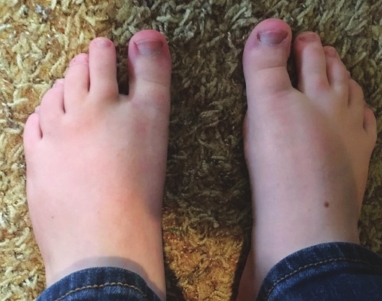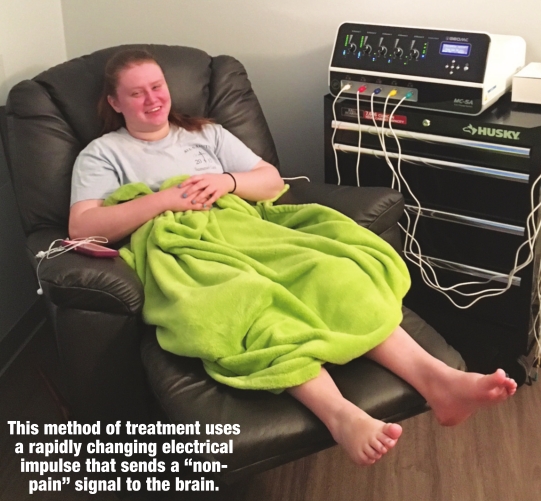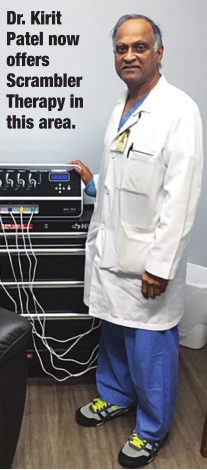SCRAMBLER THERAPY

When Reggie Greening's daughter Amanda began having inexplicable pain in her left foot, the two were left frustrated by treatment options in managing her severe discomfort. As time progressed, so did the symptoms, including discoloration, burning and swelling, resulting in his daughter's inability to walk. The only relief Amanda was provided was through the use of opioid medications, which she was required to take every four to six hours. This left both Amanda and her father concerned, and Amanda still in pain. Through a long journey of searching for a diagnosis through various physicians for his daughter, Greening discovered Scrambler Therapy in his research for a more sustainable treatment option.
The efforts made to get answers as to why Amanda was experiencing so much pain and rendered unable to walk were extensive. Greening stated the family saw a plethora of doctors, including a podiatrist, an orthopedic doctor, rheumatologist, dermatologist, physical therapists, homeopathic doctors, chiropractor, a pain management doctor and a general medicine doctor. These physicians performed numerous scans and tests, including two MRIs – one with contrast dye injected intravenously – a three-phase bone scan and a nerve conductivity test. Ultimately, through trials and suspected causes, Amanda was diagnosed with Complex Regional Pain Syndrome (CRPS).
Once Greening had a confirmed diagnosis for Amanda, he was armed with information in seeking a more effective and safer way to manage her pain – which was described as "bone-crushing ... [as if] with a red-hot anvil." Greening stated that after she was put on opioid medications, she used this method of pain management for five months, but that its relief was minimal at best.
“Nothing took the pain away completely, [and] most other options were incredibly invasive,” he said.
After seeing a YouTube video of a doctor in New Jersey showcasing the benefits and procedures of Scrambler Therapy – specifically for those with CRPS and other nerve conditions – Greening was given hope. Thus began his search for physicians with the Scrambler Therapy machine near the Shreveport-Bossier area. Amanda’s first treatment was administered by a doctor of osteopathics in Dallas, Texas.
After her fourth day of treatment, which was performed consecutively, the family was amazed to find her able to walk with the help of crutches for the first time in seven months. The next day of treatment allowed Amanda to walk completely independently.
 Greening feels passionately about bringing awareness to the option of Scrambler Therapy. The treatment allowed Amanda to be free of opioids and NSAID pain relievers. In this effort to maintain his daughter's improvement, Greening found that Dr. Kirit Patel in the Shreveport-Bossier area has recently begun providing the therapy. Patel has been serving patients in the area in the fields of internal medicine, critical care, pulmonary disease and palliative care. He has been performing Scrambler Therapy for patients for just over six weeks but echoes the benefits of this effective alternative to opioid pain management.
Greening feels passionately about bringing awareness to the option of Scrambler Therapy. The treatment allowed Amanda to be free of opioids and NSAID pain relievers. In this effort to maintain his daughter's improvement, Greening found that Dr. Kirit Patel in the Shreveport-Bossier area has recently begun providing the therapy. Patel has been serving patients in the area in the fields of internal medicine, critical care, pulmonary disease and palliative care. He has been performing Scrambler Therapy for patients for just over six weeks but echoes the benefits of this effective alternative to opioid pain management.
“This is a non-narcotic, noninvasive, pain-free treatment with no known side effects,” said Patel. “It uses a biophysical [meaning that it uses a physical method] rather than a biochemical [meaning drugs] approach.”
Patel explained that Scrambler Therapy uses a machine which uses electrodes and targets the specific pain site.
“The device relieves pain directly at the pain site through small electrodes through which a ‘no-pain’ message is transmitted directly to the nerve for about 60 minutes using 16 distinct algorithms,” he said. “During the treatments, the patient’s pain steadily decreases as the brain gets the ‘message’ that there is no more pain at the original pain site. In some cases, pain relief has been reported in as few as one to three treatments, but each patient’s case is unique.”
“Patients are comfortably connected to the device via small electrodes – similar to those used in EKG and other medical procedures – placed on the patient’s skin at the pain sites,” he continued. “The device then sends a very low current of electrical stimulation through the skin and nerve fibers, which carries a ‘no pain’ signal to the brain, essentially overriding the previous pain signal.”
The individual treatment sessions can take about one hour and can consist of 10-12 treatment sessions over a two-week period. Patel stated that there are times in which an additional booster treatment may be performed as needed.
Greening hopes that he can help spread the message of Scrambler Therapy in order to have its treatment more accessible and available to those suffering from nerve conditions, and act as an effective, safe alternative to opioid pain management. Amanda still deals with some symptoms in her foot but is otherwise completely painfree and no longer requires any pain medications. She is considered in a maintenance phase and receives treatment sessions from Patel on an asneeded basis.
– Katie Ho


